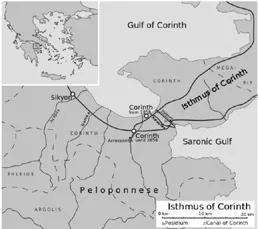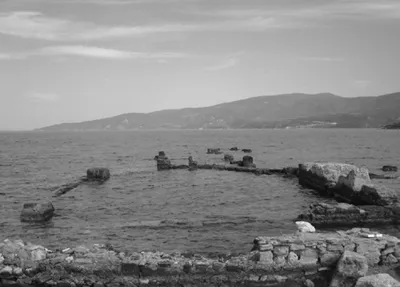![]()
PART I
SETTING THE STAGE,
GATHERING THE PROPS
![]()
1
FROM EPHESUS TO CORINTH— BEARING AN EXPLOSIVE LETTER
Early June, 54 CE, on the Aegean Sea between Asia Minor (Turkey) and Achaia (Greece). Four travelers—three men and a woman—squinted into the western sun as they stood on the deck of a small ship sailing on the Aegean Sea toward their destination, Corinth’s seaport in southern Greece. Ahead of them, the afternoon sun back lit the Isthmus ridge hiding the mighty Acrocorinth, the mountain protecting the city below and crowned with the temple of Aphrodite, goddess of erotic passion.
Stephanas (1 Corinthians 16:17) squeezed his wife Julia’s hand as they neared the port town of Cenchreae on the Isthmus of Corinth. He was both excited and apprehensive. Rolled up inside his tunic lay a precious letter from their brother in Christ, Paul of Tarsus—longer and more detailed than any Paul had ever written before. Its contents were potentially explosive and he and Julia were charged with reading it to people who may not want to hear it. At least they had the support of their comrades, Fortunatus and Achaicus.
For Fortunatus and Achaicus (1 Corinthians 16:17), this calm sea of early summer was a welcome contrast to their April trip in the opposite direction across the Aegean to Ephesus.
Two months earlier… Because of unpredictable weather, most shipping took place only between late May and November. But Chloe, their employer and a house church leader in Corinth (1 Corinthians 1:11), had not wanted to wait. She had been worried sick about the quarreling and tensions pervading most of the house churches in the region. To add to the distress, scanty rainfall over the winter portended another serious drought and a poor summer harvest. This would increase the general unrest and widen the gap between the haves and the have-nots.
Surely Paul would know what to do—but he was planting churches in Ephesus. Chloe had appealed to Phoebe, another house church leader (Romans 16:1-2), and the owner of a shipping firm in Corinth’s eastern port of Cenchreae. Phoebe was willing to send one of her smaller ships to Ephesus with an early cargo, so Chloe had dispatched two of her employees, Fortunatus and Achaicus, to report to Paul on the growing crisis. Despite the risk at sea, the young men were eager to travel. Never having left the Corinthia, they had only heard of Ephesus’s magnificent library, colossal theater, and sidewalks of inlaid mosaics.
Meanwhile, on the other side of Corinth… While Chloe and her household were making these arrangements, Stephanas and Julia were equally alarmed at what was happening to the house churches on their side of the city. As Christian leaders, they had consulted with other church members in Corinth—mostly those with some education or aspirations to public office—both Gentiles and Jews.
The result was a letter that they had personally taken to Paul in mid-May. It contained a list of questions and comments about how they should conduct their lives as worshipers of Jesus rather than of the emperor in Rome. Believers from different classes and backgrounds in their assemblies had differing ideas—hence, the friction. Some were annoyed by Paul’s comments in an earlier letter about not associating with their “immoral” pagan friends and neighbors (see 1 Corinthians 5:9).
Arriving in Ephesus, Stephanas and Julia had found Paul in the tent-making shop off Kouretes Street that he rented with Prisca (Priscilla) and Aquila. They also met Sosthenes, the former synagogue official in Corinth who had taken the rap for Paul the day angry Jews hauled him before the governor (Acts 18:12-17). Sosthenes had lost his leadership position at the synagogue, because his sympathies for the Jesus movement became known. He eventually joined Paul in Ephesus, reaching out to the Jewish community there.
Each evening after the shop closed at sunset, the believers shared a simple meal—a supper of the Lord, as Paul named it—with any converted or interested Ephesians who came. Then followed several hours of discussion or even heated debate about the nature of Paul’s gospel and what he needed to tell his struggling assemblies in Corinth.
WRITING THE LETTER
Before the arrival of Stephanas and Julia, Paul and Sosthenes had already begun a letter of response to the Corinthian Christians. Fortunatus and Achaicus had told them all about the troubles. The carefully worded theology of the first section had given way to shock and outrage at some of the stories the men recounted. (Andronicus did what?!) Now Paul also had to respond to this letter the Corinthian believers had sent to him. Through these weeks of prayer and conversation, the Spirit had gradually given them wisdom and insight.
Paul did not have a scribal hand, so he dictated his letter to Prisca, a well-educated daughter of a Roman noble. Stephanas often went to sleep in the flickering light of an oil lamp, listening to the low tones of dictation and the scratch of pen on papyrus. Paul signed the letter with his own hand, affirming his love and concern for all his flock in Corinth.
Ancient harbor at Cenchreae, Corinth’s port on the Saronic Gulf and Aegean Sea. Paul’s coworker Phoebe heads a house church in this town. Paul’s letter arrives here by ship from Ephesus across the Aegean Sea in Asia Minor.
HOME TO CORINTH
Now this very scroll burned inside Stephanas’s tunic. As the harbor at Cenchreae grew larger in the distance, he could see the docks and the small temple of the goddess Isis just behind them. Finally the captain maneuvered the ship past the fishnets and docked the boat.
The four travelers disembarked and walked along the shore to the house of Phoebe, leader of the Jesus-believers who lived in this port city. They would spend the night with her family and in the morning depart for Corinth, ten kilometers to the west.
Though eager for home, the travelers shared their worries with each other as they approached Phoebe’s house. How would the believers take Paul’s letter? They were not comfortable with everything in it themselves. Gifted in rhetoric, Paul had not minced words. Now this letter must be read to each assembly of believers as forcefully as possible. At least Phoebe, like Prisca, trusted Paul and knew how to handle his passions and anxieties. Hopefully she would help interpret the letter to those whom Paul was most strongly criticizing.
In the meantime, the travelers received a joyful welcome from Phoebe’s household as they embraced each other in the growing twilight.
JUNE 2009 CE, THE CORINTHIA, GREECE
The characters in the scene just described were long gone when we (Reta and George) were part of a small group spending ten days in Greece, exploring the ruins of ancient Corinth and the surrounding region called the Corinthia. We spent two days with Dr. David Pettegrew, a professor of Roman history at Messiah College and an archeologist who spends summers digging in Cyprus and Corinth. Besides the ancient city center where tourists visit, David led us through weeds and rocks to other ancient remains we would never have found on our own.
Of special interest was a freestanding private villa with space enough to handle a small assembly of twenty to twenty-five people. Is this the sort of house where Stephanas and Julia lived—or could they only afford renting a tenement apartment?
A spiritual highlight awaited at the remains of Corinth’s eastern port, Cenchreae. We sat on the rocks of an ancient stone dock, kicking our feet in the peaceful waters of the Aegean. We imagined Paul saying goodbye to his Corinthian brothers and sisters, then sailing from this spot with his coworkers, Prisca and Aquila, to plant churches in Ephesus (Acts 18:18-21). Where was Phoebe’s house? Did she really own a shipping company which would have given her enough wealth to serve as patron to Paul and other Christian leaders? The Spirit hovered here, as real as sea gulls flapping overhead.
The papyrus scroll that Stephanas carried to Corinth (as we imagine it) has long ago disintegrated. But its words lived on, painstakingly copied over and over and read aloud in churches throughout the Roman Empire. Finally the letter was bound into a collection and viewed as authoritative for the Christian church as a whole. Translated from Greek into Latin and uncounted other languages, today it is part of our Bible, one of the thirteen letters attributed to the apostle Paul.
A LOVE-HATE RELATIONSHIP WITH PAUL
How you hear Paul’s words depends a lot on which church tradition you come from. In some, you hear more sermons from Paul’s letters than any other part of the Bible. Paul’s words are seen as literally God’s words, applied directly to you or your congregation. Many Pauline texts sustain your spiritual life—though perhaps others induce guilt or inadequacy.
On the other hand, you may not like Paul. You think he’s a hoary old conservative, out of touch with the twenty-first century. He’s bossy, domineering, pro-slavery, anti-women, and anti-gay, you think. Leave Paul alone and stick with Jesus and the four Gospels!
Or maybe you’re somewhere in between. Like the first group, you are spiritually sustained when Paul writes about faith, hope, and love. With Paul you work for unity and desire to be “in Christ.” But you ignore or wince at what he writes in other places. Paul arouses mixed emotions.
But is there yet another way to look at Paul? Can we put ourselves in the place of those first-century believers who knew Paul before his letters were considered Scripture, when they felt free to argue and debate with him? Can we see him as one charismatic evangelist among others?
The intent of this book is to interact with Paul’s Corinthian letter as if we really were those Christians in Corinth. Then, as we more clearly experience what Paul meant in the first century, we can better understand what his writings mean in our twenty-first century context. Indeed, if we do not do so, we will often get it wrong, sometimes with hurtful results.
BRIDGING THE TIME AND CULTURE GAP
It is not easy to recreate the context of a letter nearly 2000 years old. We must remember the apt phrase, “The past is a foreign country. They do things differently there.”1 We must explain the unquestioned use of slaves, the practice of killing animals to appease the gods, the odd sexual behaviors of converted pagans, the reasons why veils were worn or not worn, or the high esteem in which ecstatic speech was held.
Rome’s inhabitants would have ridiculed Western concepts of democracy and the “self-evident” Enlightenment ideal that “all people are created equal.” Nothing was more “self-evident” to them than that people were not created equal.
But for all that, human nature has changed very little. We face many of the same issues in our society and religious institutions that Paul confronted: competition, polarization, greed, one-upmanship, sex addictions and infidelities, issues of food and hunger, gender and ethnic inequalities, diverse religious practices, fear of illness and death, tensions between worship of God and allegiance to one’s country.
Our reflection on 1 Corinthians and our research into its cultural background have led us to the conclusion that the basic issue for Paul in this letter is one of social class, status, and the insidious impact of the corrupt values of the Roman Empire. Hierarchies were everywhere. Patrons and clients were bound to each other by tight relationships of inequality. Women were considered by nature to be inferior to men. Wealth was created on the backs of enslaved bodies with no rights whatsoever. Everyone was locked into “their place” in a tight pyramid. At the top sat the emperor, high priest of an ...




